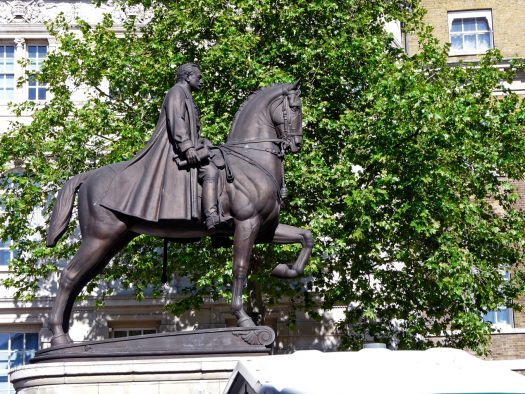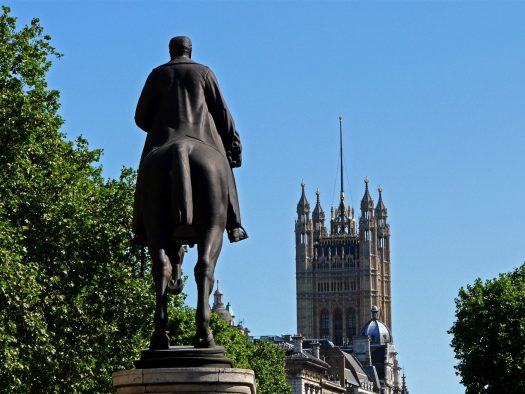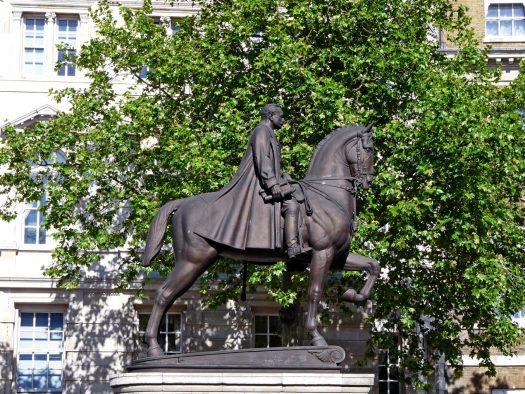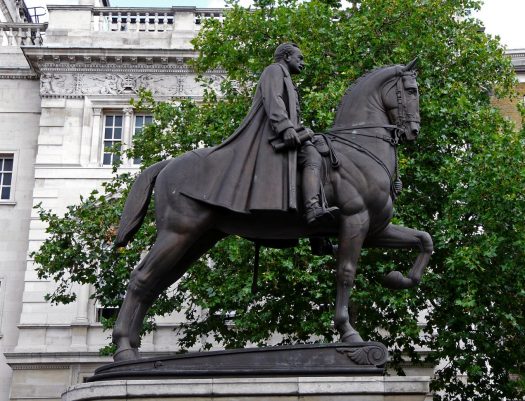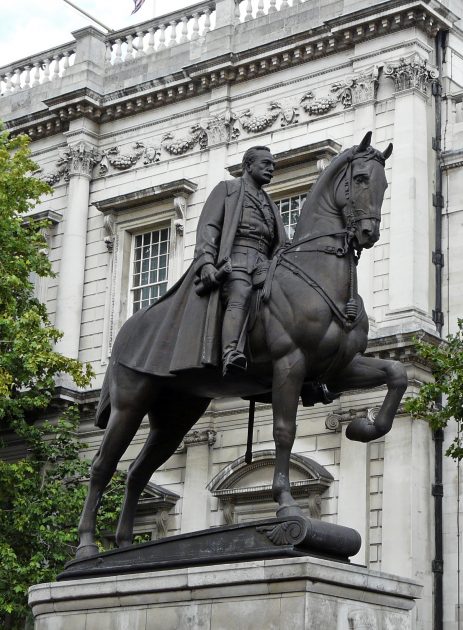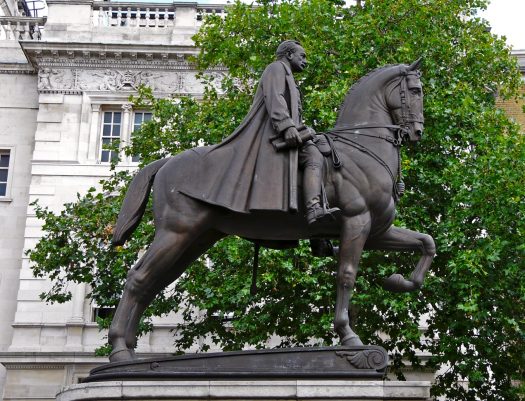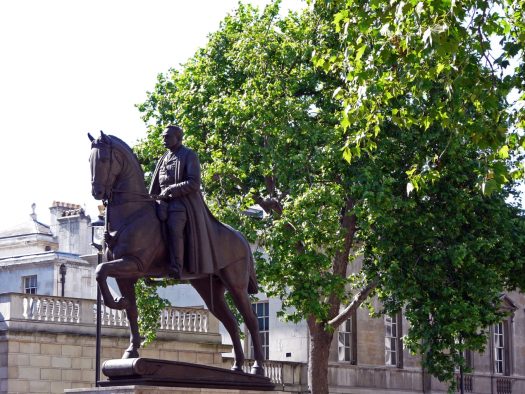The public dispute with respect to the equestrian statue of Haig is characteristic of the many disputes about equestrian statues in the UK. Just to get an impression of the issues raised with respect to these statues, here are some lengthy quotes from an interesting article written in 2008 by Nicholas Watkins, A kick in the teeth:
The London statue was dogged by controversy from its first proposal in 1928. According to the planning the statue should be completed in 1931, but was unveiled only in 1937. The question was: should it be a memorial that would stand the test of time as a work of art or just an effective representation of Haig?
Hardiman won the competition. His ambition to commemorate both the physical appearance of the hero and the ideals he represented was not new, but to go out on a limb and create a highly stylized, hybrid horse, more draft horse than classical charger, mounted by the more naturalistic Field Marshal, was to court controversy in a horsy nation.
In a letter to The Times Lord Mildmay of Flete thundered: ‘There is nothing symbolical about badly and wrongly made boots and breeches. And then the horse!… Why must we in our search for symbolism go back to a travesty of the Elgin marbles for our ideal horse, and present a horse which no real horseman would be paid to ride and which Lord Haig would not have looked at?’
Haig, a distinguished horseman, who hunted whenever possible and wrote a manual on cavalry training, fully espoused the natural seat and was gifted with ‘good hands’. For him to be shown riding ‘like a German’, on a bastardised classical horse, not an English thoroughbred, was to equate him with the enemy. This became a repeated refrain in subsequent criticism of the monument.
Earle (responsible for the commission to Hardiman) established the case for the defence:
As regards the horse, the various equestrian statues that I know, Marcus Aurelius at Rome, the Colleoni at Venice, and the Gattamelata statue at Padua by Donatello, all these three great statues have designs of horses, which probably we have never any of us seen actually in the flesh, and yet they look quite splendid.
This was the line Hardiman himself adopted in his only public comment, published in the Daily Mail: the monument had to ‘stand for 500 years, not five minutes’.
The generals were never going to like the horse: Is this statue to represent the late Commander-in-Chief of the British Armies in France as men knew him, or as an artistic representation of that strength and determination of purpose which were embodied in Lord Haig’s character? If the former be the accepted view then, the statue fails, and it is difficult to understand why it should be impossible to get an adequate representation of a charger in bronze suitable for Whitehall. If the latter view is to prevail, the matter is one for artists, and not for soldiers.
The generals were outflanked: the matter was going to be left to the artist.
The Edinburgh Evening News, in a lengthy article, headlined ‘Was Equestrian Statue Obligatory?’ repeated the previous criticisms of the horse and followed D.S. MacColl’s earlier observation in questioning the relevance of commemorating a modern commander-in-chief with an equestrian monument when he was habitually in a motor car or at his desk dictating to a typist. As it would be difficult to make him then look sufficiently heroic, the article suggested that Haig should be represented standing in his customary easy pose:
That would have given posterity a better idea of this excellent and unassuming leader of men than if he were hoisted aloft on a war-steed, which if well conceived would only distract attention from the rider, and if badly done would render him ridiculous.
The unveiling in 1937 passed off without incident. Reactions from the press generally focused on assessing the monument, rather than stoking up the embers of the controversy. The monument was there, and they had to come to terms with it. For the Times it was ‘an agreeable surprise’. For the Manchester Guardian: ‘It has dignity’. Both papers concurred in rating it among the best equestrian monuments in London. The Daily Express remained true to its colours with an article headlined ‘Hatless Haig on “Circus” Horse Annoys Veterans’.
The stance of the hind legs will have, to anyone who has had anything to do with horses, an immediate significance of which the sculptor may be unaware (urinating).
Conclusion for Hardiman: the monument was both a personal triumph and a tragic commitment that blighted his best years and left him penniless. After working for eight years he was out of pocket by £156. Few sculptors have had to endure the opposition of the King, the subject’s widow, a battery of generals and military experts, and seemingly the public, orchestrated by a virulent press campaign.
What started out as a monument to the leader of the greatest victory in British military history finally ended the century as a reminder for the tabloid press of slaughter and human sacrifice on an unimaginable scale. The Daily Express front page headline of 6 November 1998, accompanied by a photograph of the monument to Field Marshal Earl Haig, read: ‘Why do we let this man cast a shadow over our war dead?’ and proposed that it be melted down and the metal used to mint medals for the families of those executed as deserters and mutineers.
The corollary of Hardiman’s updated classicism and the preferred style of his critics was a form of naturalism. In one sense it could be regarded as a case of highbrow versus lowbrow, the art camp versus the military and its sympathisers, but in another it encapsulated two very different traditions: the classical and the Renaissance to convey concepts and naturalism to commemorate the appearance of the hero and by extension his horse. Hardiman attempted to accommodate both traditions. He was in fact complimented on his lifelike portrayal of the Field Marshal, but failed to satisfy his critics. Lady Haig’s cri de coeur that her husband was a ‘simple man’ struck a chord. Hardiman attempted to convey the dignified simplicity and moral strength of Haig. However, a simpler, more democratic form of commemoration suited the mood of the times. Public memory could no longer be satisfactorily constructed around the image of the mounted military leader.
The genre itself had come to look outmoded in an age of mechanical and chemical warfare. The perceived hero of the First World War was the citizen conscript, the Tommy with the upturned rifle, and not the leader. The equestrian monument to the heroic military leader, as D. S. MacColl predicted, had had its day in the United Kingdom. Hardiman’s monument to Field Marshal Earl Haig was in fact to be the last of its kind.
